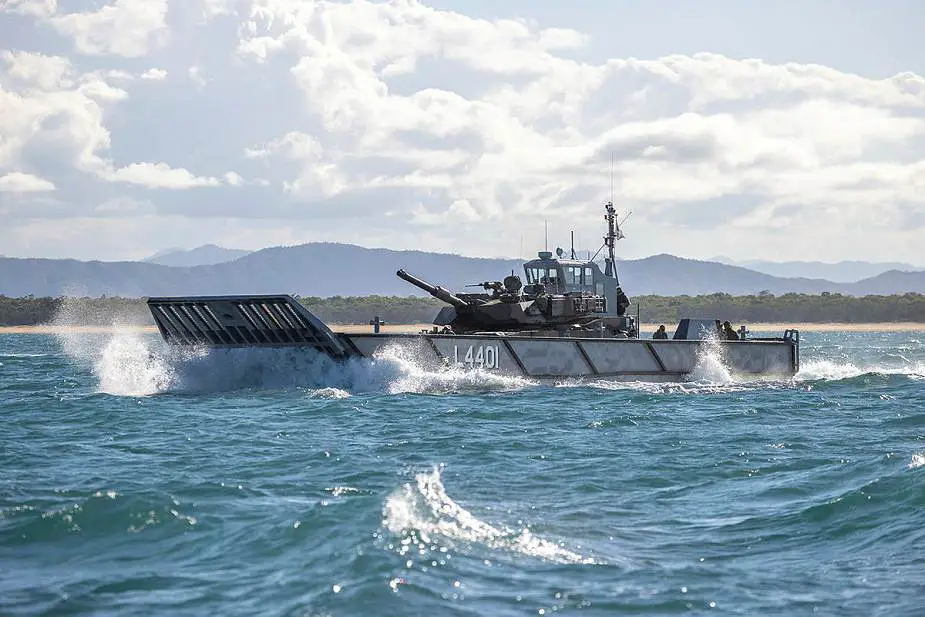Breaking news
First tactical deployment of M1A1 Abrams tanks on landing crafts for Australian Amphibious Forces.
According to information released by the Australian Department of Defence on June 15, 2021, Australian defence forces have conducted the Exercise Sea Explorer with about 1800 ADF (Australian Defence Forces) personnel taking part and for the first time, the tactical deployment of M1A1 Abrams tanks was exercised in amphibious operations.
Follow Navy Recognition on Google News at this link
 An Australian Army M1A1 Abrams Tank being transported on a Royal Australian Navy landing craft LCM-1E, during Exercise Sea Explorer, Cowley Beach, Queensland. (Picture source Australian DoD)
An Australian Army M1A1 Abrams Tank being transported on a Royal Australian Navy landing craft LCM-1E, during Exercise Sea Explorer, Cowley Beach, Queensland. (Picture source Australian DoD)
The Australian Amphibious Force achieved the milestone at Cowley Beach in North Queensland during Exercise Sea Explorer, the second major activity of the Sea Series suite of exercises.
Commander 1st Division Major General Jake Ellwood said the achievement showed Defence is advancing its warfighting capability in the coastal environment.
Embarked in HMA Ships Canberra and Choules, the Australian Amphibious Force conducted wet and dry environmental rehearsals, combat enhancement training and force integration. Australian troops trained day and night to familiarise forces with the conduct of amphibious operations.
The HMAS Canberra (L02) is the lead ship of the Canberra-class landing helicopter dock in service with the Australian Navy. The ship is able to transport 1,046 soldiers and their equipment. Two vehicle decks (one for light vehicles, the other for heavy vehicles and tanks) have areas of 1,880 square metres (20,200 sq ft) and 1,410 square metres (15,200 sq ft) respectively, and between them can accommodate up to 110 vehicles. The well deck will carry up to four LHD Landing Craft (LLC), which can be launched and recovered in conditions up to Sea State 4.
The flight deck can operate six MRH-90-size helicopters or four Chinook-size helicopters simultaneously, in conditions up to Sea State 5. A mix of MRH-90 transport helicopters and Sikorsky S-70B Seahawk anti-submarine helicopters will be carried: up to eight can be stored in the hangar deck, and the light vehicle deck can be repurposed to fit another ten.
The HMAS Coules is an amphibious Landing Ship in service with the Australian Navy. She has a displacement of 16,000 tons, a length of 176 m, a wide of 24 m and is capable to carry over 300 troops, 23 Abrams main battle tanks, 150 light Trucks, LCVP, Landing Craft Mechanised (LCM8) and is also capable of operating Navy helicopters including the MRH-90 Taipan and Sikorsky MH-60R Seahawk and the Australian Army’s S-70A Black Hawk.
During the Sea Explorer exercise, Australian Defences have conducted landing amphibious operations using LHD landing craft (LLC) LCM-1E to deploy M1A1 Abrams main battle tank. The LCM-1E is a class of amphibious Landing Craft, Mechanized (LCM) manufactured by Navantia who also build the LHD hulls. In the Royal Australian Navy service these crafts are purpose-built for the Landing Helicopter Dock (LHD) and are referred to as LHD Landing Craft (LLC).
These landing crafts are intended to deliver troops and equipment onshore where there are no fixed port facilities. They have the ability to be used Over The Horizon, which means that the LCM-1E can transport between the ship and the coast starting at a distance greater than that marks the horizon, i.e. greater than 20 nautical miles (37 km). To perform this type of landing, the LCM-1E are equipped with radar navigation, GPS, gyro needle/magnetic and HF communications equipment, VHF and UHF.





























